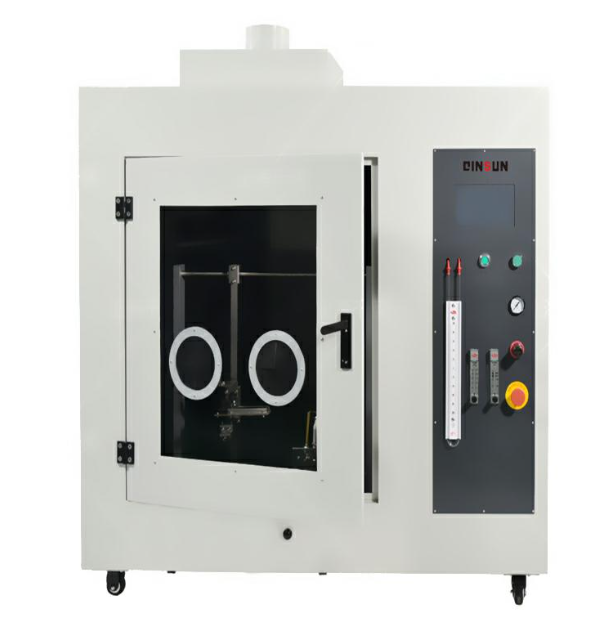
Horizontal and vertical combustion tester
2025/08/04
Equipment Overview:
The horizontal and vertical flame tester series is primarily used for horizontal and vertical flammability testing of plastic and other non-metallic component samples, solid materials, and foam plastics with an apparent density of at least 250 kg/m² when measured according to ISO 845.

Test Principle:
Based on the test flames specified in the standard, the 500W test flame is used for horizontal and vertical burning tests, with materials classified as 5VA or 5VB. The 50W test flame is used for horizontal and vertical burning tests, with materials classified as HB, HB40. and HB75 for horizontal burning tests and V-0. V-1. and V-2 for vertical burning tests.
This unit utilizes an integral air intake and ignition system with a combustion delay of only 0.1 seconds, ensuring sufficient combustion time. The black background and multi-function flame gauge simplify flame adjustment. The all-stainless steel housing features a large observation window.
Using an integrated HMI + PLC operating system, the touchscreen control screen divides the test into separate controls for the 500W horizontal and vertical burning tests, the 50W horizontal burning test, and the 50W vertical burning test. The test procedures are standardized according to the standard test methods, with clear control steps and easy operation. The control screen features a high degree of automation and highly accurate parameter display.
According to GB/T5169.16-2017 Fire Hazard Tests for Electrical and Electronic Products, Part 16: Test Flame 50W Horizontal and Vertical Flame Test Method (optional item), Clause 9.2.3:
Clause 9.2.3 requires flame application and observation:
Maintain the central axis of the burner tube in a vertical position, facing the wide side of the specimen. Approach the specimen horizontally. Apply the test flame from the centerline to the midpoint of the specimen's bottom edge. To achieve this, position the burner tip 10 mm ± 1 mm below the midpoint. Maintain the burner at this distance for 10 seconds ± 0.5 seconds (starting with the flame completely below the specimen). Move the burner within the vertical plane as the specimen position or length changes. Combustion Lamp (Bunsen Burner) Control: After the flame is ignited, the tester automatically moves to the combustion position. After the burning time expires, the tester automatically returns to its original position, repeating this cycle. At the end of the test, the flame automatically extinguishes and the tester automatically returns to its original position, eliminating the need for frequent ignition during the combustion test.
Flame tracking of specimen deformation during the combustion process: The specimen follows the flame.
The specimen fixture features three-axis movement, with a maximum specimen travel distance of 300mm. Each direction is driven by a speed-controlled motor and manually controlled by a mobile control box located outside the chamber. Each direction has a separate forward and backward (or up and down, left and right) button, and a speed knob for adjusting specimen movement speed at any time. The experimenter can observe the flame combustion and specimen deformation through the observation window. A 50W vertical flame-to-specimen distance gauge is mounted on the upper portion of the combustion lamp for convenient observation and operation.
While the specimen follows the flame, the specimen movement speed can be adjusted at any time by pressing the direction buttons, making operation simple. (The flame following function is primarily designed for soft specimens and is optional, considering the accuracy of each test.)
This product features an attractive appearance and combines many advantages of similar domestic and international products, offering stable performance, convenient operation, and easy observation.
Applications:
The horizontal and vertical flame tester is suitable for the research, production, and quality inspection of electrical and electronic products and their components, including lighting equipment, low-voltage electrical appliances, household appliances, machine tool electrical appliances, motors, power tools, electronic instruments, electrical meters, information technology equipment, electrical utility equipment, electrical connectors and accessories. It is also suitable for use in the insulation materials, engineering plastics, and other solid combustible materials industries.
Previous: Leather Seam Fatigue Tester: A Comprehensive Explanation from Principle to Appli
N e x t : Multifunctional scratch tester



